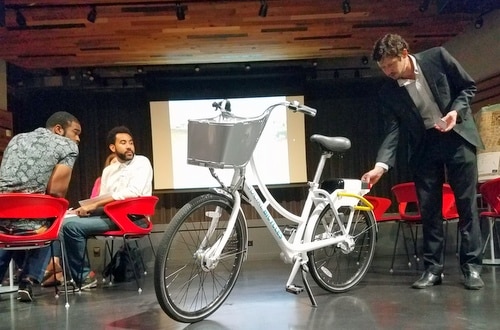
Dwight Norton, mobility coordinator for the City of New Orleans, demonstrates a social bicycle at the Peoples Health Jazz Market on Wednesday night. (Robert Morris, UptownMessenger.com)

Six neighborhoods will be included in the launch of the bike-sharing program. (map via City of New Orleans)
The city is launching a fleet of 700 “social bicycles” this fall that will be located at 70 stations in neighborhoods and gathering points, officials have said. Members of the bike-sharing program will be able to unlock them using electronic card readers, and the bicycles will have GPS to track their locations.
The specific locations for the docking stations have yet to be determined, but the city plans to distribute them roughly evenly in six core neighborhoods first: the Central Business District, the French Quarter, Maringy/Bywater, Mid-City/Bayou St. John, Treme/Esplanade Ridge, and Central City/Lower Garden District. Each of those neighborhoods has been holding public-input sessions about possible locations for the stations, and the Central City/Lower Garden District meeting drew about 20 participants to the Peoples Health Jazz Market on Wednesday evening.
The individual stations will have corrals for from as few as six bikes to twice as many or more, depending on the amount of traffic expected at the location, said Dwight Norton, the city’s mobility coordinator. The hope is to place them roughly four to seven blocks apart, so that no one has to walk more than two or three blocks to get to one.
“If someone is walking five or 10 blocks, we know participation drops dramatically,” Norton said. “The further you are from a bike station, the less likely you are to participate.”
While public input will drive the selection of the locations, a few general principles apply, Norton said:
- Stations should be accessible 24 hours a day, so inside a park that is gated at night won’t work.
- They should generally be on public property, though privately-owned land may be considered if it is in an area open to the public, such as in front of a university campus.
- They also should avoid public locations that are periodically inaccessible, such as specific parts of St. Charles Avenue during Mardi Gras parades.
- Some sunlight should be able to reach the corrals, since the technology on the bikes is solar powered.
- Connections to other forms of transit infrastructure — such as bikeways like the Lafitte Greenway or bus stations — is an asset as well.
After Norton’s introduction, the attendees broke into four small groups, each with their own copy of the Lower Garden District/Central City map to discuss. Its boundaries generally run from Jackson Avenue to the Pontchartrain Expressway, from Simon Bolivar to the river, but Norton urged attendees to make the case if they strongly support a location just outside the area.

Attendees discuss various locations for bike-sharing stations around the Lower Garden District and Central City. (Robert Morris, UptownMessenger.com)
One group, for example, started by noting the abundance of possible locations along O.C. Haley Boulevard, such as the Roux Carre food court and Ashe Cultural Arts Center. Another started by placing their stickers around the perimeter of Coliseum Square.
Attendees debated whether stations should be nearer the popular stops on St. Charles Avenue or a block off it on less vehicle-heavy Prytania Street. Others noted that even if the stations are on major thoroughfares, bicyclists could still easily ride on nearby side streets.
While the discussion maintained a congenial tone, the group members dived into the weeds of individual locations as well. One group debated the merits of stations near the Convention Center, but decided to refocus on making sure the residential areas were well represented instead. Another man, however, urged them to reconsider a station near Mardi Gras World. The facility might pitch in to create a larger station in an effort to bring more people by, he noted, but it would also serve residents because so many major events are held there.
After the groups finished working on their maps, Norton said the city will take their input — more than 30 points on some of the maps — and synthesize it into a shorter number of choices, aiming for around a dozen selections Norton said. Those will then be placed online for more public review and voting on possible alternatives. Once that data is collected, city officials will make final checks to confirm each location will be suitable, and begin work on the stations.

Orange dots on a poster-sized map of the Central City/Lower Garden District area show one group’s suggested locations for bike-sharing stations. (Robert Morris, UptownMessenger.com)
To read our live coverage of the meeting, see below.
None at Audubon park ?
I think that will come with their first expansion. It’s a private venture, so they are sticking with the low risk tourist area first.
I wish the city would prioritize street repair and police over things like this bike-share program. I was surprised to see how many city workers are being dedicated to this thing. I assumed the private contractor that was awarded the bike sharing contract would bear the cost of staffing all these meetings.
Thanks
Sounds fair
I was further surprised to learn that the City is giving away for free to the privately-owned bike-share contractor all the street and neutral ground space for the bike rental stations ! The bike-share scheme is being called additional public transit, but is actually just for tourists based on the planned routes. The City of New Orleans will have no share in the profit, but is providing land and use of their staff for free.